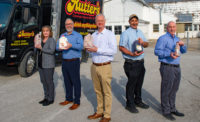An old adage says: “If you want something done right, do it yourself.” This saying perfectly encapsulates the operations of Rutter’s Dairy, which produces fluid milk along with some juice and tea products at its York, Pa.-based plant. Not only does the company work with local farmers to ensure the quality of its milk source, but it also controls the product after it leaves its facility by operating its own truck fleet.
In fact, if you are from Pennsylvania, Virginia or Maryland, you probably recognize the bright red of Rutter’s Dairy’s trucks delivering milk to local grocery stores. This is an appropriate transition for a 100-year-old company that got its start as a “milkman” — delivering milk products to the local community.
Brett Garner, director of operations, says when he began working for Rutter’s in the early ‘90s, the company was still providing home milk delivery. Rutter’s had to shift its operations over the past several decades to accommodate new retail customers and distributors as home delivery went away. And production volume also has increased at its facility. Today the plant processes 70,000 gallons of milk a day.
Milk in many formats
The Rutter’s plant receives raw milk daily, says Garner, and the plant operates 24 hours a day for six days a week. Milk is sourced from farms within a 100-mile radius, and Rutter’s immediately begins tracking its milk supply in case of any problems.
“Every [milk] load that comes in has four, five, six farms on it,” explains Sue Wise, quality assurance manager. “After that load comes in and it's tested for the antibiotics, we put it in a tank and we know exactly which tank it is. And when they pull from that tank for production, we know exactly what tank it is. So we can follow the flow and back it into a farm if we have to.”
After milk is received from the milk tankers, it moves into one of three milk silos. From the silos, milk travels into Rutter’s 5,000-gallon-an-hour pasteurizer.
“From the pasteurizer, then we can go a couple of different ways,” Garner explains. “It goes through the separator, and we can make everything from HVD [homogenized vitamin D] to skim milk because we take all our milk and split it into skim and cream. Then we blend it back together for whatever butterfat percentage we want. If we're making 2% milk, then we blend back in enough cream to bring it back up to 2% and send it to a storage tank.”
Rutter’s plant has 10 tanks to hold the pasteurized product until it is bottled. The milk travels from those storage tanks to the packaging lines, where it is bottled. The plant operates five filling lines — one for gallon containers, one for half-gallon containers, one for pints/quarts and two for half-pints — notes Brett Goodling, plant manager.
After being packaged, the milk is stored in Rutter’s five-story refrigerator, Garner says. Milk that is processed on a given day normally is put into Rutter’s trucks that evening and is delivered to customers the following morning.
Local sourcing
Rutter’s relies on its own network of 28 local farmers in the surrounding six counties as its primary milk source. The company works directly with those farms to verify the quality of their milk through weekly testing as the milk comes in, Wise says. Rutter’s also has a farm inspector on staff who checks that the farms with which the plant partners are meeting FDA standards.
“If we see that there's a problem in their milk throughout our testing, we call them; we send a farm inspector out to work with them,” Wise emphasizes. “We have chemical suppliers that will go out and check their systems. We have outside labs that offer some assistance if they've got something going on that we don't like.”
Wise explains that Rutter is “very tied into helping” the farmers with which it works. For example, the dairy participates in a program for its milk suppliers called Farmers Assuring Responsible Management (FARM).
“It’s all about cow safety and cow happiness and the way they're treated and taken care of,” she says. “Because a happier cow gives better milk.”
Rutter’s also supplements its milk supply from partner farmers with milk from two local cooperatives, explains Garner. These farms are still within a 100-mile radius and are also held to the standards of the FARM program, as well as Rutter’s quality checks.
Because Rutter’s also operates its own fleet of approximately 30 trucks, it also has control over the transportation of its product.
“We're putting everything on our own truck, so we have it in our control right up to the store level,” says Garner. “We're doing a lot of direct store delivery. If a store is buying from a warehouse program, that's not always the case.”
A sanitation, safety standout
One unique element of Rutter’s plant operations is that its staff actually cleans all of its equipment by hand, explains Garner. The second shift at the facility, from 2 p.m. to 10 p.m., is a sanitation shift.
“Most places CIP [clean in place] their fillers, but we tear ours down because we feel that we do a better job,” he emphasizes.
To check if cleaning was effective, Rutter’s does ATP swabs on all the equipment after the sanitation shift, says Wise.
Rutter’s plant is SQF Level 3 certified. In addition, the company does shelf-life testing that goes beyond what the shelf life allowed in Pennsylvania, Wise says.
“In Pennsylvania, we're only allowed to have a 17-day sell-by date. We test out to 24 days to make sure that we're still in compliance,” she notes. “So I know they did a really good job on the line if we are within specs at a 24-day shelf life.”
If, for whatever reason, Rutter’s QA team notices that there is an issue during its shelf-life testing, they go back to the equipment operators who were working at the time the milk was produced and work together to find an answer.
“We can ask them if they noticed anything different. We can check our chemical concentrations,” Wise explains. “I can see exactly who was on the line, and they can tell me what they pulled apart or if they noticed anything unusual.”
While Rutter’s keeps some product back for shelf-life testing, it doesn’t hold the lion’s share of its offerings for more testing due to milk’s short shelf life, Wise points out. Instead, the company has 16 checks from the beginning of processing to the end that its products need to pass during production.
“It would start with the sanitation and their chemical concentrations on the cleaning, and then the swabs for ATP,” she says. “There are weight checks. There are butterfat checks. Some flavor testing throughout the day.”
The on-site laboratory where Wise runs food-safety checks is certified by the state of Pennsylvania, notes Garner.
“We're certified to do our producer testing for payment purposes. We also do our finished product testing for ourselves,” Wise adds. “But we are required once a month to send the finished product out to a commercial lab for testing for FDA purposes.”
Turnover not an issue
One point of pride for Rutter’s is that its plant has very little turnover, says Garner. In fact, many of its employees have been with the plant for decades. Some recent retirees from the facility had worked for Rutter’s for 40 years.
“That's kind of a key to our success — [that] we have a lot of longevity. We have a lot of experience in our workforce,” Garner points out. “You know, we're not training new people all the time. So we really don't do a whole lot of new training because we have very few new people coming in.”
When Rutter’s does need to hire new employees, it looks for hard workers. New hires immediately go through a food safety training with Wise, she explains. After that training, new hires are put on the floor to learn about production equipment “from a current operator, as well as the managers that are there.”
Rutter’s also conducts Occupational Safety and Health Administration compliance trainings where new staff learns about chemicals and fire safety, among other employee safety concerns.
Employees typically go through annual food safety refresher training, too, says Garner. However, it’s a bit hard to get everyone together right now because of the pandemic, so Rutter’s instead conducted one-on-one refreshers with its plant employees this past year.
While there isn’t a set employment path with Rutter’s, it is very common for the company to promote from within, notes Goodling.
“If they want to move up, they can move up,” he adds “We have opportunities for them to move up if they [want to].”
Because employees are cross-trained on equipment, it can be easier for them to change job roles. That cross-training has also been helpful in the current COVID-19 era — in case an employee is out sick, Goodling notes.
Able to adapt
Speaking of the pandemic, Rutter’s made some changes to its plant when it started to ensure a safe operation. According to Wise, the company instituted “a lot of employee separating” to make sure workspaces were 15 to 20 feet apart. The company also changed breakroom policies — so that employees were eating lunch by themselves — and added more hand-sanitizing stations.
“We were lucky enough that we were already social distanced and that it didn't become a problem,” says Garner.
The plant also has had to change its operations a bit to respond to changing customer demands during the pandemic, Garner says. For example, Rutter’s has always been a big supplier of school milk, but that business disappeared when many schools moved to remote learning.
“We did see, on the other side of that, gallons increase because more people stayed home for the year,” he says. “So instead of selling a half pint … we’re selling half gallons; we’re selling gallons because the kids are at home.”







